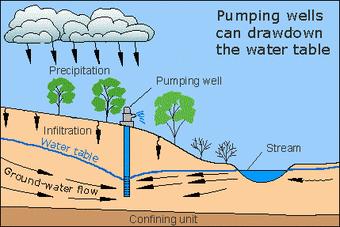
In a suit listing dozens of defendants, including Groundwater Sustainability Agencies for the Oakdale Irrigation District, Stanislaus County, and the cities of Stockton, Lodi, and Manteca, the California Sportfishing Protection Alliance (CSPA) has alleged that in adopting their Groundwater Sustainability Plan (GSP), the various agencies and authorities involved failed to follow procedures required by California’s Sustainable Groundwater Management Act (SGMA) which was signed into law September 16, 2014.
More critically, CSPA claims that, “the GSP does not achieve sustainable groundwater management…and “is not likely to achieve the sustainability goal established by the GSP within 20 years.”
For anyone watching groundwater use in the San Joaquin Valley over the last decade, the lawsuit comes as no surprise. Especially since the rush to plant nut orchards in the eastern foothills, drawdown of aquifers has accelerated far beyond nature’s capacity for restoration. The CSPA suit focuses specifically on the Eastern San Joaquin Groundwater Subbasin, which lies north east of the City of Modesto. In a recently released study of groundwater levels in 2019, aquifers in the north eastern foothills of the Valley are among the most severely depleted, even after the above average water years of 2017 and 2019.
It was clear from the beginning of the formation of the many Groundwater Sustainability Agencies throughout the Valley that without fallowing hundreds of thousands of acres of farmland it would be impossible to achieve groundwater sustainability. It was even more apparent that with so many agencies and too many conflicts of interest to count, enforcement of any real standards could not be left to local authorities.
Though Groundwater Sustainability Plans (GSP) were required, the twenty-plus year window to achieve sustainability offered plenty of wiggle room for any agency that wanted to avoid the severe measures needed to achieve sustainable groundwater use. And when local experts like retired USGS hydrologist Dr. Vance Kennedy recommended simple metrics for evaluating progress toward sustainable use, resistance was unified and adamant.
Early on, Kennedy suggested that groundwater basins be measured by a “mass balance” estimate. In its simplest application, a mass balance equation is like measuring a checking account—it begins with a measurement of water in the basin, then calculates water coming and water going out.
Kennedy also pointed out that rainfall was a very small factor in groundwater recharge; he said rivers, lakes, and streams were far more significant. Then he added that the youngest groundwater in the eastern foothills of San Joaquin and Stanislaus Counties was almost certainly at least a thousand years old.
 Though Dr. Kennedy was an award-winning hydrologist with impeccable credentials, no one was truly interested in simple arithmetic. Measuring water in versus water out would have made too apparent what everyone already knew—far more water was going out than coming in.
Though Dr. Kennedy was an award-winning hydrologist with impeccable credentials, no one was truly interested in simple arithmetic. Measuring water in versus water out would have made too apparent what everyone already knew—far more water was going out than coming in.
Problems for members of the various Groundwater Sustainability Agencies were compounded by the Oakdale Irrigation District’s (OID) repeated water sales to buyers far south of the Eastern San Joaquin and Modesto groundwater basins. The sales suggested the region had surplus water when in fact groundwater levels were declining.
Farmers who are dependent on groundwater believe the solution to groundwater depletion is to bring more water from northern California, even though doing so will wreak economic havoc on fisheries and environmental havoc on ecosystems, especially the San Joaquin Delta and San Francisco Bay. Absent northern California surface water, these same farmers will keep pumping until they can pump no more—they just don’t want to have to admit that fact when confronted by SGMA.
Most everyone has known since its inception that SGMA would require a day of reckoning, though most expected it would come from the state. CSPA has brought that day sooner than many expected, but it is almost certainly only the first salvo in what is likely to be barrage of lawsuits. And once forced to explain how more water going out than coming in equals sustainability, Valley Groundwater Sustainability Authorities will find themselves at the mercy of a very simple arithmetic.

We face the same issue in Butte Count, .where the “Tuscan Water District” has petitioned our Local Agency Formation Commission to form the third largest water district in the State. The proposed new entity is intended to improve the “resiliency” of our groundwater supply to facilitate more water transfers to meet the unlimited demand by urban and agricultural users south of the Delta.. There appears to be little or no interest by urban developers or agricultural users in limiting their use of water or to re-use treated and recycled urban effluent to reduce use.. These users ignore the fact that “sustainability” is fundamentally inconsistent with the unavoidable fact that all Groundwater Sustainability Agencies must set firm limits on all use… Neither developed agriculture nor urban development can continue to expand and grow without limit forever. It is time to acknowledge this simple fact and to act upon it.